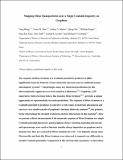Mapping Dirac quasiparticles near a single Coulomb impurity on graphene
Author(s)
Wang, Yang; Brar, Victor W.; Shytov, Andrey V.; Wu, Qiong; Regan, William; Tsai, Hsin-Zon; Zettl, Alex; Crommie, Michael F.; Levitov, Leonid; ... Show more Show less
DownloadLevitov_Mapping Dirac.pdf (3.411Mb)
OPEN_ACCESS_POLICY
Open Access Policy
Creative Commons Attribution-Noncommercial-Share Alike
Terms of use
Metadata
Show full item recordAbstract
The response of Dirac fermions to a Coulomb potential is predicted to differ significantly from how non-relativistic electrons behave in traditional atomic and impurity systems. Surprisingly, many key theoretical predictions for this ultra-relativistic regime have not been tested. Graphene, a two-dimensional material in which electrons behave like massless Dirac fermions, provides a unique opportunity to test such predictions. Graphene’s response to a Coulomb potential also offers insight into important material characteristics, including graphene’s intrinsic dielectric constant, which is the primary factor determining the strength of electron–electron interactions in graphene. Here we present a direct measurement of the nanoscale response of Dirac fermions to a single Coulomb potential placed on a gated graphene device. Scanning tunnelling microscopy was used to fabricate tunable charge impurities on graphene, and to image electronic screening around them for a Q = +1|e| charge state. Electron-like and hole-like Dirac fermions were observed to respond differently to a Coulomb potential. Comparing the observed electron–hole asymmetry to theoretical simulations has allowed us to test predictions for how Dirac fermions behave near a Coulomb potential, as well as extract graphene’s intrinsic dielectric constant: ε[subscript g] = 3.0±1.0. This small value of ε[subscript g] indicates that electron–electron interactions can contribute significantly to graphene properties.
Date issued
2012-07Department
Massachusetts Institute of Technology. Department of PhysicsJournal
Nature Physics
Publisher
Nature Publishing Group
Citation
Wang, Yang, Victor W. Brar, Andrey V. Shytov, Qiong Wu, William Regan, Hsin-Zon Tsai, Alex Zettl, Leonid S. Levitov, and Michael F. Crommie. “Mapping Dirac Quasiparticles Near a Single Coulomb Impurity on Graphene.” Nature Physics 8, no. 9 (July 29, 2012): 653–657.
Version: Original manuscript
ISSN
1745-2473
1745-2481